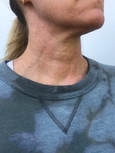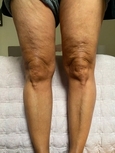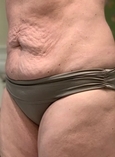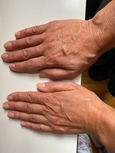Crepey Skin
krayp · y –skinCrepey skin is skin that’s lost elasticity and appears finely wrinkled like tissue paper.
Also Called
Tissue skin, thin skin, thinning skin, fragile skin
Frequently Found On
Neck, chest, arms, stomach, and eyelids

What is crepey skin?
Crepey skin is skin that has the texture and appearance of crepe paper, like hundreds of very fine lines that may gather or sag in certain areas, like the upper arms, elbows, eyelids, and neck. It’s common in dry, older skin because as the body ages it produces less collagen and elastin, proteins that make skin smooth and taut. But it’s not always an aging issue. People who’ve lost a significant amount of weight in a short period of time and women who’ve just given birth may also experience crepey skin.
“Crepey skin can be just due to the natural causes of aging,” says Dr. Melissa Kanchanapoomi Levin, board-certified dermatologist and founder of Entière Dermatology in New York. “We inherently lose important proteins and structural content in our skin, whether that's collagen, elastin, hyaluronic acid, other natural moisturizing factors, as well as structural components. Crepey skin could also be due to lack of moisture, whether that's from the aging process or just from environmental exposure.”
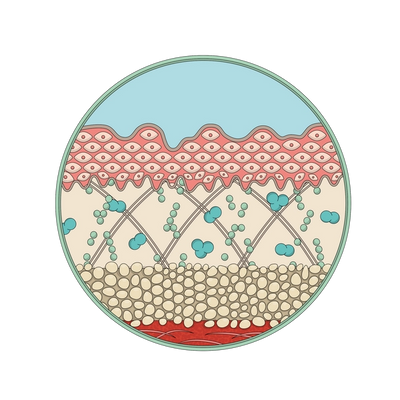
Crepey skin is a colloquial term, not a medical one. Scientists and doctors usually rope it in with the signs of aging skin along with wrinkles, sun spots, and wearing fluorescent pink lipstick to play Bridge on Tuesdays. It’s an aesthetic issue, it causes no harm other than to our vanity, and like so many skin conditions in the same boat, it’s not extensively studied. But dermatologists, cosmetic dermatologists, and plastic surgeons have a variety of treatment options you can explore based on your skin type. “Crepey skin is not the end of the world,” says Dr. Levin. “But there are fantastic treatments that we can do that stay on top of it, or even treat it, for sure.”
Crepey skin can be somewhat prevented with thick moisturizers and creams to rehydrate the skin, and retinoids that stimulate collagen production beneath the skin’s surface. Skin that’s already crepey can be treated with tightening treatments, laser therapies, and fillers, among many other options.
“I often say that dermatology is a really interesting intersection between medicine, beauty, artistry, science, but also psychiatry,” says Dr. Levin. “Oftentimes our skin reflects what's going on internally, systemically, but the skin also exists as a barrier, our first line of defense.” So if you’re panicking about your crepey skin, she adds, “The important thing is to normalize it. These are natural things that happen. They're not disease processes, but they’re natural conditions of human existence.” Aging is inevitable, so some may choose to do nothing about their crepey skin and get on with their life—and that works too.
What causes crepey skin?
The most common cause of crepey skin is simply the skin aging. Starting in early adulthood, every year the body produces slightly less collagen, elastin, sebum, and hyaluronic acid—substances that naturally moisturize the skin and make it smooth and tight.1 Over time, that loss adds up and the skin gets thinner, drier, and looser. Sun damage is a major cause of crepey skin because ultraviolet light breaks down collagen and elastin. It’s a subtle, long term damage that happens below the surface of the skin while we’re forgetting to slather on a second layer of sunscreen at the beach. (In fact, UV damage is estimated to be responsible for 80% of skin aging signs.)2
Genetics and environmental factors can determine your likelihood for crepey skin too. Smoking definitely plays a role in exacerbating skin aging,3 as does excessive alcohol consumption.4 There could be a combination of reasons the skin gets crepey, some of them preventable (wear that SPF) and some of them not (age happens).
“You can also have crepey skin from excessive or very quick weight loss,” says Dr. Melissa Kanchanapoomi Levin. “Women see crepey skin on their abdomen after having children because their abdominal skin stretched to accommodate the baby, and then it goes back after they deliver the baby.”
Not moisturizing generously and often can contribute to crepey skin, as can having excess fat on the body that sags with age—the list goes on. “Inherently there’s sun damage,” says Dr. Levin, “But multiple factors are playing a role.”
How do you treat crepey skin?
The first and easiest way to treat crepey skin is with topical retinoids. Retinoids, usually in a tonic, toner, or lotion, will sink into the skin and spark the body to create collagen (long story short, retinoids are synthetic Vitamin A, which the body also produces—just not as much when you’re older). Studies have shown that fine wrinkles like crepey skin can improve after around 12 weeks of retinoid treatment.5 Retinoids are available over the counter, but talk to your dermatologist about prescription strength options that can be more effective. There are some side effects, retinoids can also be super drying, so talk to your doctor about easing into it.
“Treatment really depends on what type of crepey skin it is,” explains Dr. Melissa Kanchanapoomi Levin. “The ideal treatment regimen, in my opinion, is one that combines your maintenance at home—a good skincare routine, healthy habits that you incorporate into your life—and then the in-office treatments.”
Moisturizing regularly and incorporating retinoids are the go-to at-home crepey skin regime. At the dermatologist, there’s an array of procedural options to treat crepey skin, but keep in mind that “treat” doesn’t mean “erase it completely and transform your skin to when it was 17.”
“If there’s sun damage, we can use resurfacing lasers”—like HALO, like LaseMD, like Fraxel—“that basically heat up specific areas of the skin,” says Dr. Levin. “It not only repairs and fixes sun damage, but also increases the production of collagen and elastin. So it’s really supporting your skin and smoothing out wrinkles from the inside out.”
Other treatments include targeted ultrasound therapy that breaks down unhealthy collagen and also further stimulates the growth of collagen deep below the skin’s surface.6 “I do a ton of ultrasound therapy in my practice for the face, neck and chest, even the upper arms, for skin tightening,” says Dr. Levin.
And then there are fillers. “A lot of people know hyaluronic acid fillers,7 but we also have biostimulatory fillers, which sometimes people don’t know about,” says Dr. Levin. “They're called Radiesse and Sculptra. These types of fillers actually signal your own cells to make more collagen in the skin that then further improves the appearance, texture, thickness of crepey skin, and that stimulates the growth of collagen.”
When it comes to treating crepey skin, Dr. Levin typically takes a combination approach that treats sun damage and lack of collagen: “I might do fractionated resurfacing lasers, or as we call it, photo facials, or broadband light, BBL, to repair sun damage. And then other treatments that just focus on collagen loss and crepiness of the skin.”
The most important step in treating crepey skin is to talk to a board-certified dermatologist about your options because they’ll be different for every person depending on your skin type, age, and budget (laser treatments are considered cosmetic and not covered by insurance).
Mass Index Recommends:

Soft Services
Smoothing Solution
$30
3.3 fl oz
fragrance free
This is a leave-on chemical exfoliant containing 10% AHA to dissolve build-up of dead skin cells and soothing ingredients to calm visible irritation.
Soft Services works with experts to review the accuracy of our content, but they do not endorse the products we made.
How do you prevent crepey skin?
The truth is, you may not be able to completely prevent crepey skin. Some body facts are inevitable, and your genetic code may have it in store no matter how much designer lotion you slather on. But crepey skin can be delayed by diligent sun protection. The sun breaks down collagen and elastin in the skin, so the more the skin’s spared that sun damage, the smoother it’ll remain. There are other causes of crepey skin, like smoking (bad, always bad), but there’s nothing as damaging as those warm and welcoming UV rays, whether from the sun or tanning beds. However, by the time you’re reading this, 20 or 30 years may have passed and it might feel like it’s too late to go back and swap out the Hawaiian Tropic tanning oil for SPF 5000.
“I think a lot of people feel like it’s too late, I've already done my damage,” says Dr. Melissa Kanchanapoomi Levin. “It’s never too late to start to assume a healthy lifestyle—and we extend that to the skin as well. So even though you’ve definitely accumulated sun damage, as everyone does, there are things that you can do now.”
The most base level of sun protection is wearing SPF 30+ sunscreen, avoiding sun exposure in the middle of the day, and wearing UV-protective clothing. “I always tell my patients, your sunscreen is not a shield,” says Dr. Levin. “It works, but it’s not a hundred percent.” So don’t forget to reapply sunscreen after two hours in the sun, and rely on sun protective clothing and big floppy hats, if you’re ready to get serious about your skin health.
The second way to prevent crepey skin is to moisturize daily (or twice daily) with lotions and creams that deeply hydrate and repair the skin. Sounds obvious, but some lotions are watered down and not as effective as others, while some moisturizers, like body oils, might sit on the skin’s surface and seem shiny and hydrating but they might not be penetrating the surface.
“Most people are not moisturizing their bodies,” says Dr. Levin. “They tend to focus on their face, neck, and chest, but you really should be using a good body lotion or a body moisturizer that incorporates ingredients that are humectant, which draws moisture into the skin.” Look for body creams with ingredients that dermatologists call occlusives, which mean they lock in moisture, like glycerin and hyaluronic acid.
“There are other skincare products that we recommend,” adds Dr. Levin, “such as antioxidants like vitamin C serum, and collagen-producing ingredients like vitamin A derivatives, retinol, retinoids, and peptides." Those popular anti-aging ingredients work on a skin cell level and help revive the skin's elasticity.
Making moisturizing a regular part of your skincare routine can help prevent crepey skin as well as a range of other skin conditions, from itchy dry skin to keratosis pilaris. But remember that this is preventative, and not a guaranteed way to avoid crepey skin. Talk to your dermatologist about treatment options if you already have crepey skin and want to address it head-on.
Citations
1Skin collagen through the lifestages: importance for skin health and beauty by David M. Reilly and Jennifer Lozano. Plastic and Aesthetic Research.
2Effect of the sun on visible clinical signs of aging in Caucasian skin by Frederic Flament et al. Clin Cosmet Investig Dermatol.
3Cigarettes Smoking and Skin: A Comparison Study of the Biophysical Properties of Skin in Smokers and Non-Smokers by Taraneh Yazdanparast et al. Tanaffos.
4Impact of Smoking and Alcohol Use on Facial Aging in Women: Results of a Large Multinational, Multiracial, Cross-sectional Survey by Greg D. Goodman, MD et al. J Clin Aesthet Dermatol.
5Retinoids in the treatment of skin aging: an overview of clinical efficacy and safety by Siddharth Mukherjee et al. Clin Interv Aging.
6Noninvasive skin tightening: focus on new ultrasound techniques by Sabrina Guillen Fabi. Clin Cosmet Investig Dermatol.
7Treatment of Horizontal Neck Wrinkles with Hyaluronic Acid Filler: A Retrospective Case Series by Fangwen Tseng, MD and Hsiaoen Yu, MD.
Get Updates
There’s more to come.
Sign up to receive periodical updates on Mass Index, and to be the first to know when Soft Services launches new products. (If we don’t have any updates, we won’t email you.)


















